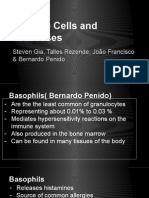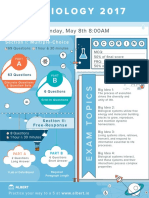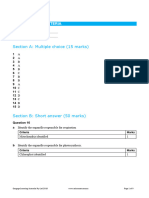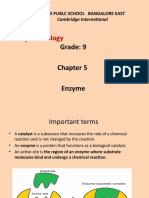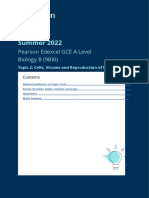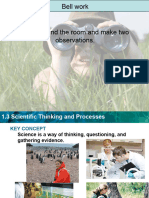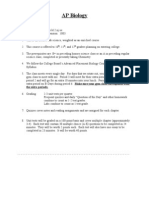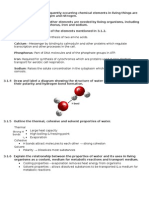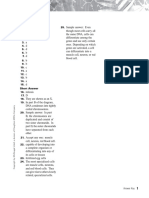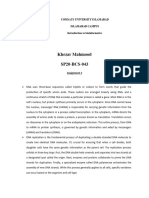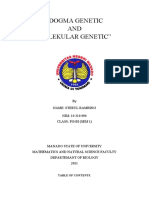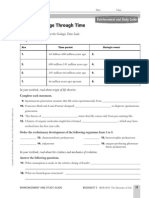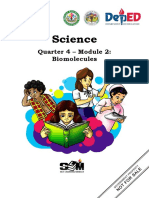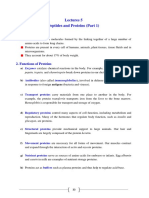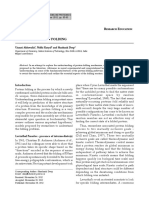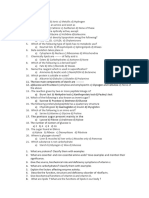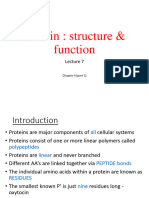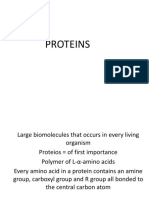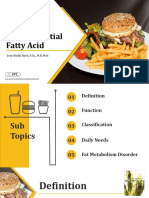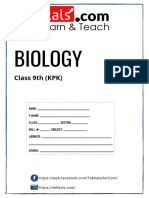THEME 1
Macromolecules
THREADS
Organisation
Selectivity
Energy Flow
Perpetuation
Evolution
Human Awareness
WORKSHEETS
1
The structure of DNA
Chromosomes are made up of genes
DNA and protein synthesis
Structure and function of protein molecules in cells
The importance of polysaccharides and lipids
DNA replication
Enzymes
DNA and protein evidence for evolution
Mutations
10
Genetic manipulation
11
Some social consequences of genetic
manipulation
12
Multiplying and sequencing DNA
�KEY IDEAS
Students should know and understand the following:
M1.
The chemical unit of genetic information in most organisms is DNA
M2.
The structural unit of information in the cell is the chromosome
M3.
The functional unit of information on the chromosome is the gene
M4.
The flow of information from DNA to protein is unidirectional in most
organisms
DNA RNA protein
M5.
The three-dimensional structure of a protein is critical to its function
M6.
Polysaccharides and lipids are important macromolecules in cells and
organisms
M7.
Specific base-pairing is the mechanism of DNA replication
M8.
Enzymes are specific for their substrate
M9.
Molecular recognition is an important property for life processes
M10. Enzymes increase reaction rates by lowering activation energy
M11. Macromolecules are used as energy reserves
M12. DNA carries genetic information from one generation to the next
M13. The universal presence of DNA is strong evidence for the common ancestry
of all living things
M14. DNA and protein sequences usually show greater similarity between closely
related groups of organisms than between distantly related groups
M15. Change in the base sequence of DNA can lead to the alteration or absence of
proteins, and to the appearance of new characteristics in the descendants
M16. Human beings can manipulate DNA
M17. Human beings can sequence even small amounts of DNA
( SSABSA Stage 2 Biology Curriculum Statement 2006, p22-24 and used with permission.
Teachers and students are advised to check the website www.ssabsa.sa.edu.sa for any changes.)
SACE 2 BIOLOGY Essentials WORKBOOK
Worksheet 1
The structure of DNA
DNAstandsfordeoxyribonucleicacid.Thismoleculeisfoundprimarilyinthenucleusofcells.Itisa
doublestrandedmoleculewiththestrandswoundaroundeachothertoformadoublehelix.The
moleculeismadeupofrepeatingunitscallednucleotides.Asinglenucleotideismadeupofthree
components:adeoxyribosesugar,aphosphateandanorganicbase.
Thediagrambelowisarepresentationof2nucleotidesbondedtogether.
Bases
Deoxyribose
sugar
Phosphate
G
A
G
A
C
C
Weak hydrogen bonds between bases
TherearefourorganicbasesfoundinDNA:Adenine,Thymine,Guanineand
Cytosine.ThelettersA,T,GandCrepresentthesebases.
AsinglestrandofDNAisasequenceofnucleotidesjoinedtogetherwith
alternatingphosphateandsugarcomponents.Thedoublehelixmoleculeconsists
oftwocomplementarystrandsthatarejoinedbyhydrogenbondsbetweenthe
bases.Thebasesalwayspairinspecificways:
AdeninealwaysbondswithThymine
GuaninealwaysbondswithCytosine
ThyminealwaysbondswithAdenine
CytosinealwaysbondswithGuanine
TheadjacentdiagramshowsthedoublehelicalmodelforDNAfirstproposed
bytwoscientistsWatsonandCrickin1953.
C
T
T
C
G
A
T
A
G
A
C
T
1. Writeaconcisestatementtoexplaineachofthefollowingterms:
complementary
...
DNA
...
macromolecule
...
monomer
...
nucleicacid
...
nucleotide
...
organic
...
polymer
...
base
...
deoxyribosesugar
...
phosphate
...
CrierieA.andGreigD.2008Allrightsarereserved,copyingisprohibitedbylaw.
Worksheet 1 THE STRUCTURE OF DNA
2. ThefollowingsequenceofbaseswasfoundinasegmentofDNA
A A G G C T T G C
Writethesequenceofbasesthatwouldbefoundinthecomplementarystrand.
.
3. NamethefourmajororganicbasesfoundinDNA.
.....
4. WritedownthefourpossiblebasepairingsinDNA.
....
5. IfasequenceofDNAhas30%guaninebasesinitwhatpercentageofthyminewouldtherebe?
....
6. Refertothediagrambelow.
Sugar
Phosphate
Sugar
Phosphate
Sugar
Phosphate
Sugar
Phosphate
Base
Base
Base
Base
(a)CircleanucleotideintherepresentationofastrandofDNAshownabove.
(b)Howmanynucleotidesareshowninthediagram?.
7. UsethefiguretolabelABCandDinthediagrambelow.
C
D
....
....
....
CrierieA.andGreigD.2008Allrightsarereserved,copyingisprohibitedbylaw.
SACE 2 BIOLOGY Essentials WORKBOOK
Worksheet 2
Chromosomes are made up of genes
ChromosomesarethreadlikestructuresmadeupofDNAandproteinscallhistones.Thesestructuresare
foundinthenucleusofeukaryoticcellsandarevisibleasthecellsstarttodivide.Thechromosome
numberisconstantforeachspecies,e.g.46inhumans,48inachimpanzee,40inamouseand38in
cabbage.ChromosomesinnondividingcellsaresinglestrandedandtheDNAisnotcondensed,thatis,
theDNAisspreadouttomakeiteasiertoaccessgenesintranscription,animportantprocessinprotein
synthesisandreplication,whereanothercopyoftheDNAismade.Whenthechromosomesarevisible
duringtheProphasestageofmitosisand/ormeiosistheyappeardoublestranded.Thisdoublinghas
occurredastheDNAhasreplicatedinorderthatnewcellscanreceivetheircomplementofDNA.
Ageneistheunitofheredity.GenesrepresentsequencesofthebasesATGandConchromosomesand
codeforproteinmoleculesorpartsofproteinmolecules.Eachgeneisfoundonaparticularchromosome.
Genesprescribethefeaturesofanorganism:greeneyes,skincolourortheshapeofanose.Inahuman
with46chromosomesitisthoughtthattherearearound40,000genes,eachchromosomecontaining
hundredsorthousandsofgenes.
Asinglegeneusuallycontainsbetween300toseveralthousandbases.Eachgenehasastartandafinish
tosignalwheretranscriptionbeginsandends.
Thediagrambelowshowsschematicrepresentationsofsomehumanchromosomesandsomeofthegene
locationsthathavebeenidentified.
Familial
Retinitis
Colon Cancer Pigmentosa
11
12
Cystic
Fibrosis
Malignant
Melanoma
Sickle Cell
Anemia
PKU
14
Alzheimer's
Disease
17
Breast
Cancer
The human genome project.
Thisisaprojectthatwasfirstproposedaround1987.Itsaimwastomaptheentiresequenceofgenesto
chromosomesandsequencethehumangenome.Thefigureaboveillustratessomeoftheknowngene
locations(loci).InAdelaideagroupofscientistsattheWomenandChildrensHospitalisinvolvedin
studyingchromosome16.Thisoverallmappingisamajorundertakingasthereareapproximately3
billionbuildingblocksornucleotidesinthetotalgenome.ThefirststagewascompletedinaboutJune
2000.
Thisphotographshowsatypicalsetofhuman
chromosomes,whichwastakenfromapreparedslide
usingalightmicroscope.
Theimageshavebeencutoutandpastedtogethertoshow
thehomologouspairs.Untilrecentlythiswasdonewith
scissors,itisnowdonewithcomputersoftwareTheyare
generallynumberedandarrangedfromlongesttoshortest.
Thesexchromosomesarebottomrightofthisphoto.
Thisisthemalesetofchromosomesorkaryotype.Afemale
hastwocopiesofthelonger(X)sexchromosome
insteadofonelong(X)andoneshort(Y).
CrierieA.andGreigD.2008Allrightsarereserved,copyingisprohibitedbylaw.
�Worksheet 2 CHROMOSOMES ARE MADE UP OF GENES
1. Writeaconcisestatementtoexplaineachofthefollowingterms:
. chromatid
...
chromosome
...
gene
...
genome
...
2. Inwhatorganellearethechromosomesfoundineukaryoticcells?
3. Whyarethechromosomesnotusuallyvisibleinnondividingcells?
...
...
4. ExplainthedifferencesbetweenDNA,genes,chromosomes.
...
...
5. Whatdoesitmeantosaythatageneislinkedtoachromosome?
...
...
6. Explainthesignificanceofdifferentspecieshavingdifferentnumbersandtypesofchromosomes?
...
.....
7. Approximatelyhowmanygenesarethere;
....
(a)ononehumanchromosome?
(b)inthehumangenome?
....
8. ScientistshaveknownforaconsiderableperiodoftimethatthegeneforcolourblindnessisontheX
chromosome.
(a)SuggesthowitwasdiscoveredthatthiswaslinkedtotheXchromosome.
...
...
(b)GeneslikethisaresaidtobeXlinkedandthecharacteristicsaresaidtobesexlinked.Explain
whythisisso.
...
...
9. Explainwhatitmeanstosaythatthestructuralunitofinformationinanorganismisthechromosome.
...
...
...
...
CrierieA.andGreigD.2008Allrightsarereserved,copyingisprohibitedbylaw.
�10
Worksheet 3
SACE 2 BIOLOGY Essentials WORKBOOK
DNA and protein synthesis
GenesontheDNAcodeforaspecificsequenceofaminoacids(aa)thatcompriseapolypeptide.Several
poypeptidesusuallymakeupaprotein.TheycanalsocodefortheproductionofanRNAmolecule.
Proteinsynthesisrequirestwosteps:transcriptionandtranslation.
Threemainnucleicacidsareinvolved.
DNA:
providesthetemplatefortheproductionofthemRNA.
mRNA:
transcribedfromtheDNAandprovidesasequenceofcodonsthatareabletobe
translatedintoasequenceofaminoacidsontheribosomes.
tRNA:
therearemorethan20differenttypesofthese,eachonecapableofcarryingonlyone
typeofaminoacid.
Transcription
ThisprocessoccursinthenucleusofacellandiswheretheDNAtemplateactsasacodetotranscribea
genesegmentofDNAbasesintoaworkingcopyofmRNA.TheenzymeinvolvediscalledRNA
Polymerase.
Thediagrambelowshowstheprocessoftranscription.
T
C
RNA polymerase
TA
Nucleotides
used to assemble
the mRNA
G
CG
C
T
T
C
C
DNA Template
G
C
C
U
UA
Growing mRNA strand
C
C
T A
U
A
T A
CG
T
mRNAnucleotidesinthenucleusarebindingtotheexposedDNAbasestoformaworkingcopyofthe
genethatwillbeabletobetranslatedontheribosomestoformprotein.
Translation
IsaprocesswherethecodonsequenceonthemRNAistranslatedintoanaminoacidlanguage.tRNA
moleculescarryspecificaminoacidsintopositionastheanticodonofthetRNAlinkswiththecodonon
themRNA.
Thenextdiagramshowstheprocessoftranslation.
CrierieA.andGreigD.2008Allrightsarereserved,copyingisprohibitedbylaw.
�Worksheet 3 DNA AND PROTEIN SYNTHESIS
Leucine
Serine
11
Growing polypeptide chain
tRNA molecule
Anti codon
A
codon
mRNA molecule
ribosome
Inthediagramabove,leucineandserinearethefirsttwoaminoacidsthatarejoinedtogetherbypeptide
bondstostartthepolypeptideorprotein.
The steps involved in protein synthesis can be set out as follows.
1.
ThedoublehelixoftheDNAunwindsandunzipsattherequiredgenesiteexposingthenitrogenous
basesonthetemplate.
2.
mRNAnucleotidebases(AUGC)attachtotheexposedDNAbaseswiththeassistanceofthe
enzymeRNApolymerase.
3.
OncethesequenceforthemRNAhasbeencompleted,themRNAisreleasedandmovesoutofthe
nucleusintothecytoplasm.
4.
TheDNAstrandswillrejoinandrecoilthemselvestoformthedoublehelix.
5.
ThemRNAmoleculeattachestotheribosomesinthecytoplasm.
6.
SpecificaminoacidscombinewiththeirappropriatetRNAmolecules.
7.
TheribosomemovesalongthemRNAmoleculeattachingtheappropriatetRNAanticodontothe
codononthemRNA.
8.
Theaminoacidsjointogethertoformapolypeptidesequence.
9.
Whenastopcodonisreachedthetranslationiscomplete.
10. Theproteinbreaksawayandisreadyforusewithinthecell,ortobepackagedandsecretedfrom
thecell.
1 Writeaconcisestatementtoexplaineachofthefollowingterms:
aminoacid
anticodon
codon
RNApolymerase
mRNA
ribosome
CrierieA.andGreigD.2008Allrightsarereserved,copyingisprohibitedbylaw.
�12
SACE 2 BIOLOGY Essentials WORKBOOK
transcription
translation
tRNA
2. TohelpyouidentifydifferencesbetweenDNA,mRNA,andtRNA,completethefollowingstatements
bywritingtheappropriatenucleicacid(s)aftereachone.
a. issinglestranded
..
b.
hasadoublehelicalstructure
..
c.
isonlyfoundinthecytoplasm
..
d.
isfoundprimarilyinthenucleusofacell
..
e.
containsthebasethymine
..
f.
containsthebaseuracil
..
g.
isinvolvedintheprocessofreplication
..
h.
carriesaminoacidstotheribosomes
..
hastripletsofbasescalledcodons
..
isfoundinboththenucleusandcytoplasm
..
k hasthreebaseswhichcomprisetheanticodon ..
3. Explaintheroleofthefollowingintheprocessofproteinsynthesis:
DNA
..
...
mRNA
..
...
tRNA
..
...
aminoacids ..
...
ribosomes ..
...
mitochondria.
..
4. Explainthedifferencebetween:
a)transcriptionandtranslation
b)acodonandananticodon
CrierieA.andGreigD.2008Allrightsarereserved,copyingisprohibitedbylaw.
�13
Worksheet 3 DNA AND PROTEIN SYNTHESIS
5. Usethediagrambelow,whichshowsasummaryoftheprocessofproteinsynthesis,towritethe
namesandrolesofthestructureslabelled:
NUCLEUS
CYTOPLASM
T
C
TA
E
G
CG
C
T
T
C
C
A
A
C
U
UA
D
J
C
C
B
C
T A
U
A
Leucine
Serine
T A
CG
T
CrierieA.andGreigD.2008Allrightsarereserved,copyingisprohibitedbylaw.
�14
SACE 2 BIOLOGY Essentials WORKBOOK
6. Thetablebelowshowswhichcodonscarrytheinformationforeachaminoacid.
UUU
UUC
UUA
UUG
phe
phe
leu
leu
UCU
UCC
UCA
UCG
ser
ser
ser
ser
UAU
UAC
UAA
UAG
tyr
tyr
stop
stop
UGU
UGC
UGA
UGG
cys
cys
stop
trp
CUU
CUC
CUA
CUG
leu
leu
leu
leu
CCU
CCC
CCA
CCG
pro
pro
pro
pro
CAU
CAC
CAA
CAG
his
his
gln
gln
CGU
CGC
CGA
CGG
arg
arg
arg
arg
AUU
AUC
AUA
AUG
ile
ile
ile
start/met
ACU
ACC
ACA
ACG
thr
thr
thr
thr
AAU
AAC
AAA
AAG
asn
asn
lys
lys
AGU
AGC
AGA
AGG
ser
ser
arg
arg
GUU
GUC
GUA
GUG
val
val
val
val
GCU
GCC
GCA
GCG
ala
ala
ala
ala
GAU
GAC
GAA
GAG
asp
asp
glu
glu
GGU
GGC
GGA
GGG
gly
gly
gly
gly
Thetablebelowshowsthenamesoftheaminoacidstogetherwiththeabbreviationsusedinthetable
above.
ala=
alanine
gly= glycine
pro= proline
arg=
arginine
his= histidine
ser= serine
asn=
asparagine
ile= isoleucine
thr= threonine
asp=
asparticacid
leu= leucine
trp= tryptophan
cys=
cysteine
lys= lysine
tyr= tyrosine
gln=
glutamine
met= methionine
val= valine
glu=
glutamicacid
phe= phenylalanine
Now,usethetableofthegeneticcodeandnamesoftheaminoacidsgiventohelpyoucompletethe
followingtable.
DNAbasetriplets
AGA
mRNAcodons
________
________
________
________
CGG
________
________
tRNAanticodons
________
________
CUG
________
aminoacidcodedfor
________
________
________
methionine
CrierieA.andGreigD.2008Allrightsarereserved,copyingisprohibitedbylaw.
�Worksheet 4 STRUCTURE AND FUNCTION OF PROTEINS
Worksheet 4
15
Structure and function of protein molecules
Proteinmoleculesarelargepolymersmadeupofabout20commonbuildingblockscalledaminoacids
linkedtogether.Organismstypically,havethousandsofthesemolecules.Humansarethoughttohave
between50,000100,000differentproteins,eachonewithauniquethreedimensionalstructurethatis
criticalforitsparticularfunction.Proteinscanbeplacedinto2maingroups,fibrousorstructural
proteins,andglobularproteins.
Protein structure can be studied at four levels
Primarystructurethesequenceofaminoacidslinkedbypeptidebonds.Eachproteinischaracterised
byitsownuniquenumber,typeandsequenceofaminoacids.Typicallyproteinsaremadeupof
hundredstothousandsofaminoacids,haemoglobin,atransportprotein,issome400timesbiggerin
sizethanaglucosemolecule.
Secondarystructurethecoilingorfoldingofthepolypeptidechain.
Tertiarystructurethethreedimensionalstructure,whichisimportantforbinding.
Quaternarystructureappliestothoseproteinswithmorethanonepolypeptidestrand.
Itisthetertiarystructureofeachspecificproteinthatdeterminesitsspecificfunction.Ifthedelicatethree
dimensionalshapeofaproteinisaltered,itusuallyfollowsthatthefunctionofthatproteinisalso
inhibited,thisiscalleddenaturation.Thediagrambelowgivesadiagrammaticrepresentationofthe
differentlevelsofstructureinamoleculeofhaemoglobinwhichisaproteinfoundinblood.
Polypeptide
chain
ala
gly
leu
val
Heme
lys
PRIMARY
STRUCTURE
SECONDARY
STRUCTURE
TERTIARY
STRUCTURE
Polypeptide
chain
QUATERNARY
STRUCTURE
Thestructuralproteinsaremorefibrousinnatureandtendtohaverepeatingunitsofaminoacid
sequences,whereastheglobularproteinseachhavetheirownuniquesequencesgivingthemtheir
particularshapethatissovitalfortheirfunction.
Types of proteins.
Proteinscanbeplacedintogroupsdependingontheirparticularrolesintheorganism.
Structural
Examplesincludethosethatmakeupligamentsandtendons,whileothersassistinmovement,for
examplemuscleproteins.Keratinisanimportantstructuralproteinfoundinorganisms,itmakesupthe
outerlayerofskin,andisthemaincomponentofhair,nails,wool,beaksandfeathers.Proteins
embeddedinthecellmembranearevitalfortheefficientfunctioningofcells.Somehaverolesinactingas
channelproteinsallowingcertainmoleculestoenterorleavecells,butnotothers.Otherproteinsactas
receptorproteinsthatcanbindtochemicalslikehormones,andthusbringaboutaparticularresponse.
Defence
Specificproteinmolecules,calledantibodies,arereleasedfromwhitebloodcellsandhavearoleinthe
inactivationanddestructionofforeignantigenmoleculesthatmayinvadeourtissues.Theuniqueshape
oftheproteinantibodymeansthattheactionofeachantibodyisspecificforaparticularantigen;one
particularantibodycanonlybindwithandinactivateoneparticularantigen.
CrierieA.andGreigD.2008Allrightsarereserved,copyingisprohibitedbylaw.
�16
SACE 2 BIOLOGY Essentials WORKBOOK
Communication
Certainmolecules,includingsomehormones,bringabouttheirspecificactionbybindingtoother
molecules.Whenthehormoneinsulinbindstoreceptorproteinsinthecellmembrane,thecellmembrane
increaseitspermeabilitytoglucoseandthecelltakesupmoreglucosetostoreasglycogen.Thediagram
belowrepresentsthebindingofahormonetoasurfacereceptor.
Hormone messenger molecule
Receptor molecule embedded
into the bi-lipid layer of
cell membrane
Lipid bi-layer
Binding leads to activation
Transport
Haemoglobinisaproteinmoleculefoundinsidehumanredbloodcells.Ithasaspecificroleinthe
transportofoxygenmoleculestothetissuesofthebody.Theparticularshapeofthemoleculemakesit
idealforthereversiblebindingthatoccurswithoxygen.
The control of metabolic reactions.
Allreactionsinsidecellsneedspecificenzymemoleculestoensurethattheyproceed.Enzymesare
proteinmoleculeswithaspecificshapethatiscriticalforthebindingofthereactantorsubstrate
molecules.Thethreedimensionalshapeoftheproteingivesrisetoanactivesiteontheenzymewherean
inducedfitbindingoccurs.
1. Writeaconcisestatementtoexplaineachofthefollowingterms:
antibody
antigen
complementarystrand..
denature
enzyme
haemoglobin
hormone
insulin
polypeptide
protein
surfacereceptor
CrierieA.andGreigD.2008Allrightsarereserved,copyingisprohibitedbylaw.
